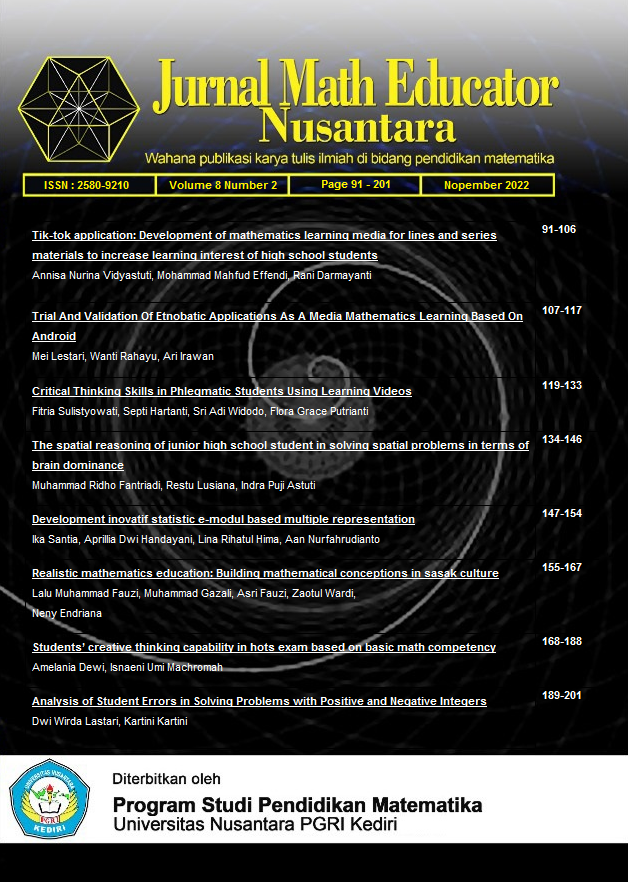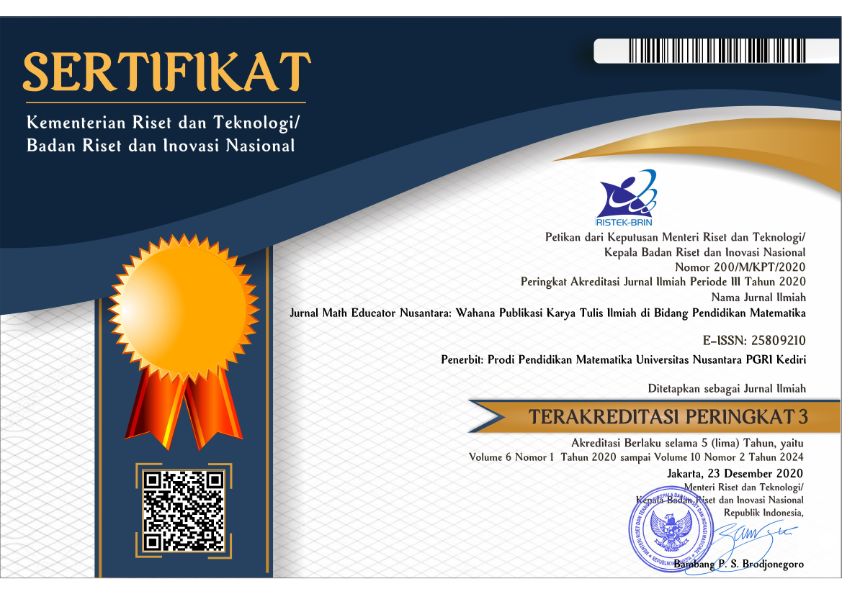The spatial reasoning of junior high school student in solving spatial problems in terms of brain dominance
DOI:
https://doi.org/10.29407/jmen.v8i2.18494Keywords:
Brain Dominance, Geometry, Spatial ReasoningAbstract
Building space is a material from geometry at the junior high school level, but there are still students who find it difficult to learn it, because in studying and solving spatial problems requires spatial reasoning. Brain Dominance is one of the factors that influence spatial reasoning. This study aims to determine the spatial reasoning of junior high school students in completing the material in terms of brain dominance. This research is a descriptive research with a qualitative approach. The supporting instruments of this research are in the form of questionnaires, tests, and interviews. Data validation method using triangulation technique. Data analysis was carried out sequentially starting from data reduction, data presentation and conclusion drawing. The results of this study indicate that students with Right Brain Dominance perform spatial reasoning by depicting objects while students with Left Brain Dominance perform spatial reasoning by means of calculations either through formulas or comparisons and there are factors from within students that also affect the spatial reasoning of participants. educate.
References
Ali, S. A., & Raza, S. (2017). A study of right and left brain dominant students at IB&M with respect to their gender, age and educational background. International Journal of Advances in Scientific Research , 1.
Azizah, N. (2022). Analisis Kemampuan Spasial Siswa SMP Kelas IX Dalam Menyelesaikan Soal Tabung Ditinjau dari Level Berpikir Geometri Van Hiele. 59.
Basyir, A. A. (2017). Pengaruh Tingkat Dominansi Otak Kiri Terhadap Kemampuan Matematika Materi Bilangan Pada Peserta Didik Tingkat SMP Negeri di Kecamatan Kebomas Gresik. 1.
Belecina, R. R., & Ocampo, J. J. (2019). Brain Dominance, Learning Styles, and Mathematics Performance of Pre-Service Mathematics Teachers. ATIKAN: Jurnal Kajian Pendidikan, , 3.
Buckley, J., Seery, N., & Canty, D. (2018). Investigating the use of spatial reasoning strategies in geometric problem solving. Int J Technol Des Educ (2019) , 3.
Cahyati, A. D., Risalah, D., & Muchtadi. (2021). Penalaran Spasial Matematika Siswa Dalam Memecahkan Masalah Bangun Ruang Sisi Datar Di Kelas VIII SMP Negeri 2 Hulu Gurung. JUSTEK : JURNAL SAINS DAN TEKNOLOGI , 2.
Duarte, R. G. (2021). Cartography And Spatial Thinking Of Brazilian Students At The End Of Junior High School. Journal of Physics , 4.
Fauzi, ,. I., & Arisetyawan, A. (2020). Analisis Kesulitan Belajar Siswa pada Materi Geometri di Sekolah Dasar. Kreano Jurnal Matematika Kreatif-Inovatif , 27.
Hidayat, K. N., & Fiantika, F. R. (2017). Analisis Proses Berfikir Spasial Siswa Pada Materi Geometri Ditinjau Dari Gaya Belajar. Prosiding SI MaNIs (Seminar Nasional Integrasi Matematika dan Nilai Islami) , 2.
Hidayat, W. S., Tristanti, L. B., Nurwiani, & Iffah, J. D. (2021). The Thinking Process Of Class IX Students Of Junior High School In Solving Problems Geometry. Advances in Social Science, Education and Humanities Research , 2.
Jafar, N., Sukayasa, & Lefrida, R. (2017). Profil Pemecahan Masalah Bangun Ruang Sisi Datar Oleh Siswa SMP Ditinjau dari Kecerdasan Visual-Spasial. Jurnal Elektronik Pendidikan Matematika Tadulako , 2.
Latifah, N., & Budiarto, T. M. (2019). PROFIL PENALARAN SPASIAL SISWA DALAM MEMECAHKAN MASALAH GEOMETRI. Jurnal Ilmiah Pendidikan Matematika , 590.
Lusiana, R., & Andari, T. (2022). Students' creative thinking ability in solving linear equation system problems based on brain domination. Jurnal Math Educator Nusantara , 10.
Murtafiah, W., Oktafian, F., & Lusiana, R. (2020). Kemampuan Metakognitif Siswa dalam Menyelesaikan Permasalahan pada Materi Pola Bilangan Ditinjau dari Brain Dominance. Jurnal Program Studi Pendidikan Matematika , 1-2.
Murtafiah, W., Oktafian, F., & Lusiana, R. (2020). Kemampuan Metakognitif Siswa Dalam Menyelesaikan Permasalahan pada Materi Pola Bilangan Ditinjau dari Brain Dominance. Jurnal Program Studi Pendidikan Matematika , 1-2.
Nithyanantham, V., & Regis, X. V. (2021). A Study on Left-Brain Dominance of the Higher Secondary Students. International Conference on Social Science Studies (IConSoS) , 2.
Nurdiansyah, A. (2017). Hubungan Kemampuan Spasial dan Kemampuan Penalaran Matematis dengan Hasil Belajar Matematika Siswa Kelas XI SMA Negeri Balung Tahun Ajaran 2016/2017. 4.
Nuryami, Janan, T., & Hasanah, N. (2022). The Influence Of Realistic Mathematics Education On Year 8 Students' Spatial Ability Of Cuboids And Cubes. Kalamatika: Jurnal Pendidikan Matematika , 1.
Oktafiani, F. (2020). Kemampuan Metakognitif Siswa SMP Dalam Menyelesaikan Permasalahan pada Materi Pola Bilangan Ditinjau dari Brain Dominance. 4.
Rahayu, S., & Jupri, A. (2021). Geometrical thinking of junior high school students on the topic of lines and angles according to Van Hiele theory. Rahayu, S., & Jupri, A. (2021). Geometrical thinking of junior high school studJournal of Physics: Conference Series , 1.
Runtukahu, T., & Kandou, S. (2014). Pembelajaran Matematika Dasar Bagi Anak Berkesulitan Belajar. Yogyakarta: AR-RUZZ MEDIA.
Setiawan, H., Fauzan, A., & Arnawa, I. M. (2021). The Development of Geometrical Learning Devices Based On Rumah Gadang Ethnomathematics for Grade VII Junior High School. Journal of Physics: Conference Series , 2.
Sukmaangara, B., & Madawistama, S. T. (2021). Convergent and Divergent Thinking in Mathematical Creative Thinking Processes in terms of Students' Brain Dominance. Southeast Asian Mathematics Education Journal , 3.
Sukmangara, B., Muhtadi, D., & Madawi, S. T. (2021). Bagaimana Siswa Menyelesaikan Soal Berpikir Kreatif Matematis Ditinjau dari Dominasi Otak? Journal of Authentic Research on Mathematics Education (JARME) , 9.
Suparmi, S., Budayasa, I., & Setianingsih, R. (2022). Kemampuan Spasial Siswa SMP Laki-Laki Maskulin dan Perempuan Feminin dalam Memecahkan Masalah Geometri. JRPM (Jurnal Review Pembelajaran Matematika) , 14.
Sutikno, Z. R. (2017). Analisis Kemampuan Penalaran Spasial Terhadap Hasil Belajar Siswa Pada Materi Memahami Sifat, Bagian-Bagian Serta Menentukan Ukuran Kubus dan Balok Kelas IX SMP Negeri 2 Patianrowo. 3.
Untari, E., Astuti, I. P., & Susa, D. (2022). Perbandingan Prestasi Belajar Siswa pada Mata Pelajaran Matematika Menggunakan Model Pembelajaran Kooperatif Tipe Make a Match, Snowball Throwing, dan Think Pair Share (TPS) Pada Pokok Bahasan Bilangan Bulat dan Pecahan Siswa Kelas VII SMPN 1 Bringin. Absis: Mathematics Education Journal , 2.
Downloads
Published
Issue
Section
License
Authors who publish with this journal agree to the following terms:
- Copyright on any article is retained by the author(s).
- The author grants the journal, the right of first publication with the work simultaneously licensed under a Creative Commons Attribution License that allows others to share the work with an acknowledgment of the work’s authorship and initial publication in this journal.
- Authors are able to enter into separate, additional contractual arrangements for the non-exclusive distribution of the journal’s published version of the work (e.g., post it to an institutional repository or publish it in a book), with an acknowledgment of its initial publication in this journal.
- Authors are permitted and encouraged to post their work online (e.g., in institutional repositories or on their website) prior to and during the submission process, as it can lead to productive exchanges, as well as earlier and greater citation of published work.
- The article and any associated published material is distributed under the Creative Commons Attribution-ShareAlike 4.0 International License
















